How to Integrate Anatomy and Pathology Content Using Courseware
Posted on 5/23/19 by Laura Snider
Today, I’m going to show you how to use Courseware to integrate content from across Visible Body’s suite of apps in a series of lessons about different common musculoskeletal pathologies. I’ll be using 2D graphics, interactive 3D models, and animations from A&P and Muscle Premium to design lessons, and I’ll use the Quiz Bank and Question Bank to access pre-made quizzes and create my own custom ones.
We’re going to go step by step through creating a series of assignments and quizzes about sciatica.
1. Create or open a course
To start, you can either create a new course or add assignments to a pre-existing course. For this tutorial, I’ve created a course called Musculoskeletal Pathologies Sample Course. You can see in the image below that I’ve already got some content in there, so I’m going to add a new folder (Sciatica) where we can put the content we’re about to generate.
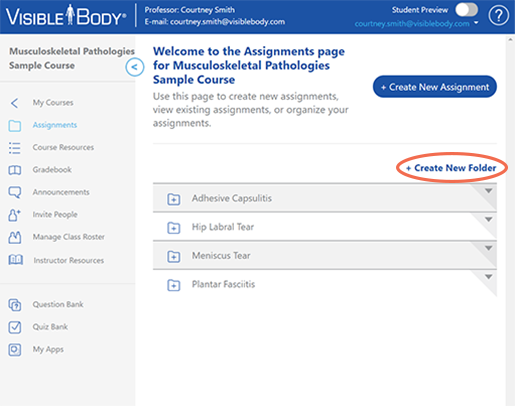
2. Spine Anatomy 1 (Assignment)
Now we’re ready to start making some assignments. A Courseware assignment is a collection of models and media from a specific VB app, so let’s have our first assignment use assets from A&P to cover the basics of spine and spinal nerve anatomy.
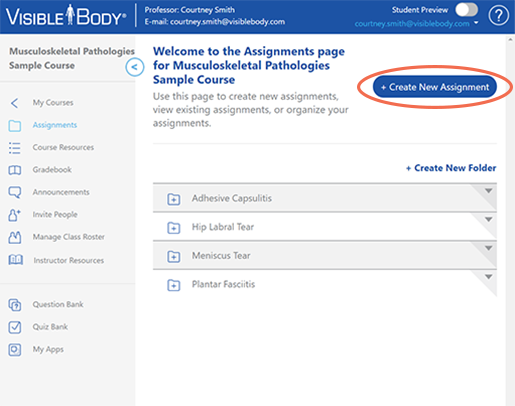
When prompted, select A&P as the app you want to draw content from.
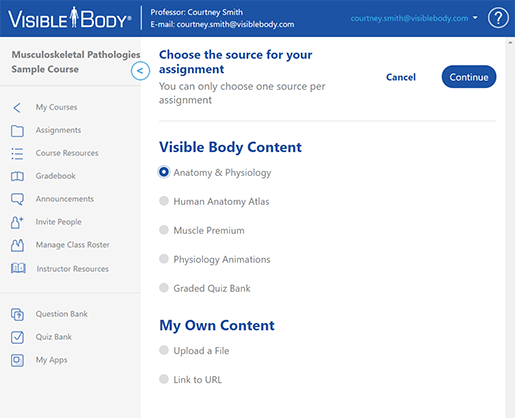
Hit the Continue button and then you can select the lessons from A&P you want to use. They’re organized by chapter, just like in the app.
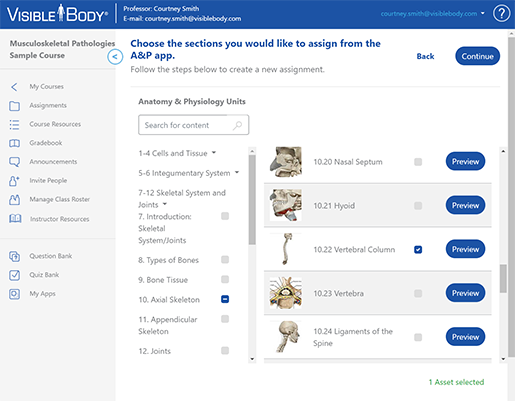
In this lesson, I added the following assets because I wanted to give an overview of basic spine anatomy, the locations of the lumbosacral spinal nerves, and how most of the vertebrae move with respect to one another.
- 10.22 Vertebral Column (shown above)
- 10.30 Lumbar Spine
- 12.10 Gliding (Plane) Joints Movement
- 12.11 Gliding Joints in the Skeleton
- 19.16 Lumbosacral Plexus 1
- 19.17 Lumbosacral Plexus 2
- 19.18 Lumbosacral Innervation
Once you’re done adding the assets you want, hit Continue again. You will be able to name and add a description to your assignment on the next page. You can also add the assignment to one of the folders in your course, or just publish it to the main course page and put it in a folder later.
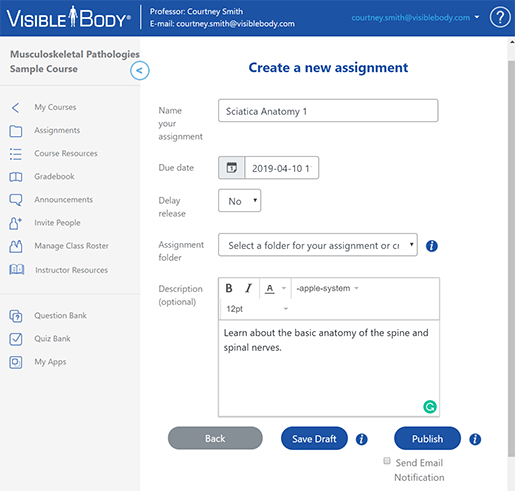
3. Spine Anatomy 2 (Assignment)
Next, we’ll create another assignment (Spine Anatomy 2) and we’ll use assets from Muscle Premium to teach students about the movements of the spine (flexion, extension, lateral flexion, and rotation) and the variety of abdominal and back muscles that make those actions possible.
The process for creating this assignment is largely the same as creating the previous one, except you’ll want to select Muscle Premium as your source of content.
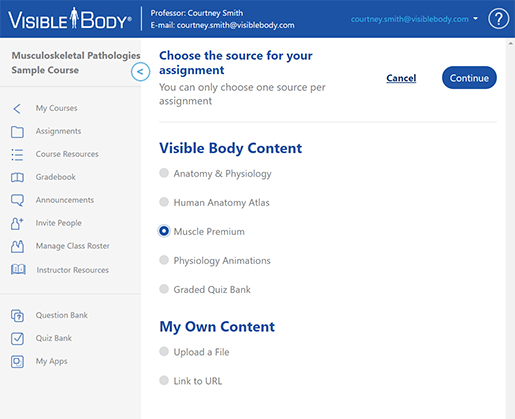
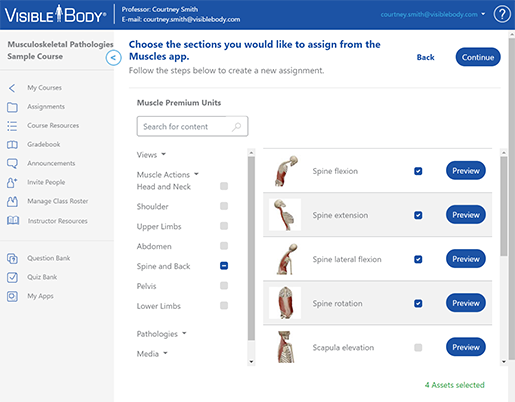
Here are the Muscle Premium Assets I chose to use for this assignment. We’ve got some 3D views and muscle actions and a video that discusses and shows the anatomy of the spine in the context of sciatica.
- Views > Spine and Back > Spine Region
- Views > Spine and Back > Spine
- Muscle Actions > Spine and Back > Spine Flexion
- Muscle Actions > Spine and Back > Spine Extension
- Muscle Actions > Spine and Back > Spine Lateral Flexion
- Muscle Actions > Spine and Back > Spine Rotation
- Media > Sciatica > Spine Anatomy and Function
4. Lumbosacral Spinal Nerves Quiz
With the anatomy review assignments complete, it’s time to check your students’ knowledge with a dissection quiz! You can find any custom quizzes you’ve created in the Quiz Bank alongside the pre-written quizzes from VB. I created a custom quiz that covers the sciatic nerve, lumbosacral trunk, and spinal nerves L04-S03.
All you have to do to add a quiz to your course is create a new assignment, select the Quiz Bank as your content source, and choose the quiz (or quizzes) you want from the Quiz Bank menu.
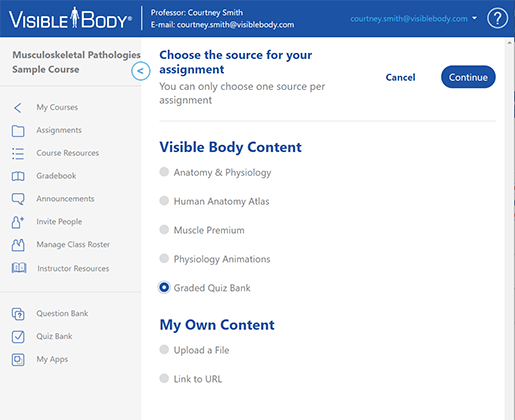
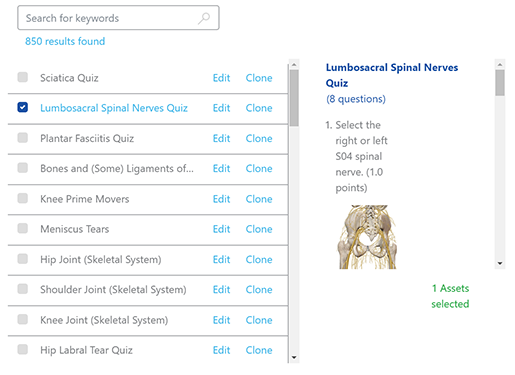
Then you can name your quiz, add a description and due date, and decide how grading will work.
5. Pathology: Sciatica (Assignment)
Now it’s time to add some assets from Muscle Premium that involve the causes and symptoms of sciatica. Once again, add a new assignment and select Muscle Premium as your content source.
I added the following assets:
- Pathologies > Spine and Back > Sciatica
- Pathologies > Spine and Back > Prolapsed Intervertebral Disc
- Media > Sciatica > Common Causes of Sciatica (Part 1)
- Media > Sciatica > Common Causes of Sciatica (Part 2)
The 3D pathology views show how a damaged disc presses on L5, one of the roots that give rise to the sciatic nerve. The videos talk about disc injury and degeneration, as well as injury to the piriformis muscle, and how they can lead to pain in the sciatic nerve. All in all, this content gives a good summary of the basics of why sciatica happens and what kinds of symptoms patients experience.
Want to see how the Hip Labral Tears pathology assignment in the sample course was made? Check out this video!
6. Sciatica Quiz
Finally, let’s add a short-answer quiz about sciatica. The steps are the same as they were for the previous quiz, except we’ll be selecting Sciatica Quiz (another custom quiz I created) from the Quiz Bank instead of the one about the lumbosacral spinal nerves.
7. Wrap-up
Once you’re done making your assignments, you can arrange them in whatever order you’d like on the course page.
Here’s how I chose to order my Sciatica and Plantar Fasciitis assignments within their folders.
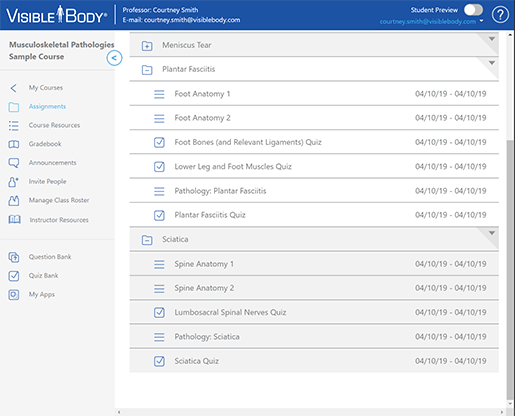
Now you have all the tools you need to integrate anatomy review and pathology basics in your own courses. Go forth and use your new knowledge!
For more Courseware tips, check out the official Courseware support site or the Courseware Demos and Tutorials YouTube playlist.
Want a copy of the course used in this tutorial? Contact our Education Team for a free demo of Courseware and ask for the Musculoskeletal Pathologies Sample Course!
- Learn more about how and why students use 3D anatomy apps in their studies.
- Interested in using virtual 3D anatomy models and animations to teach about the human body? Check out Visible Body Courseware!
- Sign up to get our awesome emails and be the first to know about free anatomy content, new blog posts and eBooks, secret sales, and more!



